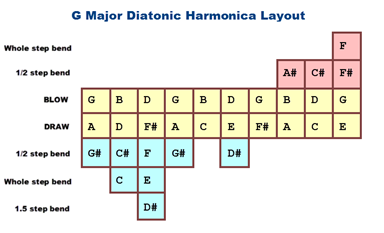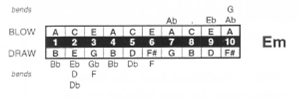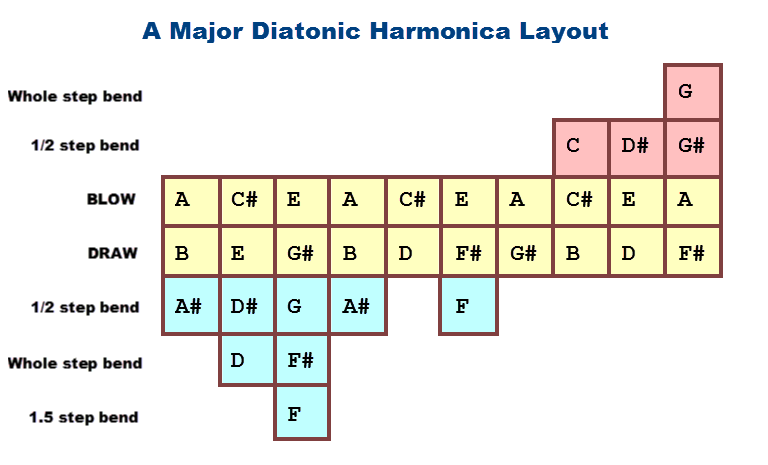Trying to create a riff for a Canadian tune (Black Velvet) which ( my band) is playing in E minor. What harp do I play and what position… Having a mental block? Thanks gang and Merry Christmas
I am thinking "G’ second position on a C harp
Depending on your bending skills, 3rd or 4th position might be a better choice. Or get a LOskar e minor harp. So a g harp in 4th? See Luke’s excellent note on position and circle of 5ths.
Hi @Bender1
My choice would be an A harp in 2nd position where the E minor pentatonic scale includes the notes at these holes: +1 -1 (your “wailer” as Jon Gindick calls it: the note is B), -2" (the flat 7 note: D), -2 (your root note E; also at +3), -3’ (NOT -3 ! It must be -3’ which is your “blue” note: the flat 3rd = G), +4 (same as +1), -4 (= -1), -5 (= -2"), +6 (= -2 & +3), and now (since you probably cannot overblow bend your +6, which would = -3’) you continue with +7 (= +1 & +4), -8 ( = -1 & -4), -9 (= -2" & -5), +9 (= -2, +3 & +6). To this pentatonic scale add -1’ & -4’ to give you the flat 5th note of the E minor scale (and this scale is now called the minor blues scale).
If you own a harp tuned for E minor, as already suggested, that gives you great results, but has a new note layout to learn – but it is pretty intuitive.
If you know 5th position then use a C harp (root note E is at +2 +5 and +8. If you know 4th position use a G harp (root E is at -3" -6 & -10) which sounds really good and is pretty easy to play.
For 3rd position use a D harp (root E is at -1 -4 & -8) which is also very easy to learn. Most people learn it after learning 2nd position, but I’ve met people who learned 3rd position before learning 2nd or even 1st position.
Thank you both. Have a Merry Christmas !
Hello @Bender1, Merry Christmas to you too.
Best Regards from Astrid ![]()
@Bender1 Hey great question here and @Slim has responded very thoroughly (as usual.) ![]()
I also would probably play A harp in 2nd position, but until recently I didn’t have the bending control to pull that off. Playing D harp 3rd position could work ok.
But honestly the easiest thing would be to buy an E Natural Minor harmonica. And that might be actually what I’d use for this song on a gig.
If you haven’t delved into Natural Minor tunings yet. Em would be a great first key to get. It’s in the same register as an A harmonica, and Em is a common key, so you’d probably get more use out of it in the future!
Hope that helps!
Save me time not looking into this myself but why a natural minor over 4th position? In 4th you’re playing all the right notes but bending is restricted. The position of the root is the big deal?


Have to say looking at the layout vs. talking position makes it more understandable. I find the 3" easier than the 3’. Ok I found the answer…
Blockquote
THE BAD
besides the difficulty of playing that -3" confidently and in tune (which is enough to be a deal-breaker for most!) you also can’t bend down the 5 so you don’t have that blue note that we get with the -4’ in cross-harp.
Wow, what a great group! Thanks to everyone who has chimed in. We have a new years gig and just passed 600 tickets. Since I am relatively new at the harp I don’t want to bring in 2024 on a wrong note… ( I hate laughing at my own jokes). I am trying to figure it out and will try and post something from the gig. Remember…. the more you drink the better I sound!
Btw @Luke you don’t have to tell me twice to buy a new harp. Lol. Wayyyyy cheaper then a new horn.
Merry Christmas gang.
@rich3 I can play in Em on a D harp in 3rd position, on a C harp in 5th position, a G harp in 4th position, and an A harp in 2nd position and be perfectly happy.
If the tune has an A7 (as opposed to Am7) then I might choose the D harp in 3rd position (this is what’s referred to as the Dorian mode, which I explain a bit here.)
But none of those options give me the CHORDAL options that I have on a Natural Minor harmonica. Playing a Natural Minor harmonica is nice for a beginner or intermediate player (and for advanced players too) because whatever bag of tricks you have for 2nd position carries over perfectly, it just sounds minor.
The only thing to note, in our example here, if you blow on an Em you get an Am. So the Natural Minor harmonicas are great fro songs that are in, err Natural Minor. If you’re playing Dorian which has the A7 instead of Am7, you can still use a Natural minor, you just have to avoid 2 and 5 and instead play -2’‘’ and -5’’ over the IV chord.
I’m sure I’ve now rambled way more info than anyone cares to read. ![]()
Thanks for the kind words and the laughs! Congrats on the 600 tickets—that’s amazing!
I’m sure you’ll bring in 2024 on a perfect note, and I can’t wait to hear your harp skills. Looking forward to seeing the post from the gig. And yes, a new Irish harps is definitely more affordable than a new horn!
Cheers to a fantastic New Year’s show!
